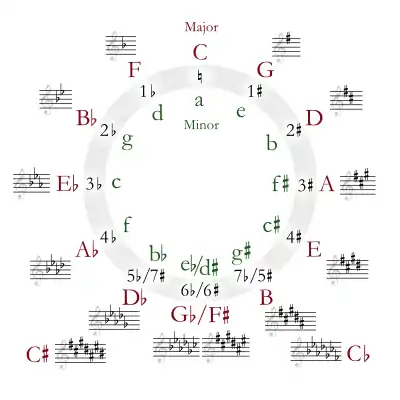| Relative key | E-sharp minor (theoretical) enharmonic: F minor |
|---|---|
| Parallel key | G-sharp minor |
| Dominant key | D-sharp major (theoretical) enharmonic: E-flat major |
| Subdominant | C-sharp major enharmonic: D-flat major |
| Enharmonic | A-flat major |
| Component pitches | |
| G♯, A♯, B♯, C♯, D♯, E♯, F | |
G-sharp major is a theoretical key based on the musical note G♯, consisting of the pitches G♯, A♯, B♯, C♯, D♯, E♯, and F![]() . Its key signature has one double sharp and six sharps.[1]
. Its key signature has one double sharp and six sharps.[1]
Its relative minor is E-sharp minor, which is usually replaced by F minor. Its parallel minor is G-sharp minor; its enharmonic equivalent is A-flat major.
The G-sharp major scale is:
Although the enharmonic key of A-flat major is preferred because A-flat major has only four flats as opposed to G-sharp major's eight sharps (including the F![]() ), G-sharp major appears as a secondary key area in several works in sharp keys, most notably in the Prelude and Fugue in C-sharp major from Johann Sebastian Bach's The Well-Tempered Clavier, Book 1. The G-sharp minor prelude (and the fugue) from the same set ends with a Picardy third, on a G-sharp major chord. G-sharp major is tonicised briefly in several of Frédéric Chopin's nocturnes in C-sharp minor. A section in the second movement of Chopin's Piano Concerto No. 1 is in G-sharp major, although the key signature has four sharps. The end of the exposition of the second movement Charles-Valentin Alkan's Grande sonate 'Les quatre âges', subtitled Quasi-Faust, is in G-sharp major, albeit written with a six-sharp key signature (the movement opens in D-sharp minor and ends in F-sharp major).
), G-sharp major appears as a secondary key area in several works in sharp keys, most notably in the Prelude and Fugue in C-sharp major from Johann Sebastian Bach's The Well-Tempered Clavier, Book 1. The G-sharp minor prelude (and the fugue) from the same set ends with a Picardy third, on a G-sharp major chord. G-sharp major is tonicised briefly in several of Frédéric Chopin's nocturnes in C-sharp minor. A section in the second movement of Chopin's Piano Concerto No. 1 is in G-sharp major, although the key signature has four sharps. The end of the exposition of the second movement Charles-Valentin Alkan's Grande sonate 'Les quatre âges', subtitled Quasi-Faust, is in G-sharp major, albeit written with a six-sharp key signature (the movement opens in D-sharp minor and ends in F-sharp major).
The final pages of A World Requiem by John Foulds are written in G-sharp major with its correct key signature shown in the vocal score including the F![]() . The key signature is shown as in the LilyPond example with the scale above, starting with the C♯ and ending at the F
. The key signature is shown as in the LilyPond example with the scale above, starting with the C♯ and ending at the F![]() .[2]
.[2]
Scale degree chords
- Tonic - G-sharp major
- Supertonic - A-sharp minor
- Mediant - B-sharp minor
- Subdominant - C-sharp major
- Dominant - D-sharp major
- Submediant - E-sharp minor
- Leading-tone - F-double-sharp diminished
References
- ↑ Thomas Busby (1840). "G-sharp major". A Dictionary of Three Thousand Musical Terms. revised by J. A. Hamilton. London: D'Almaine. p. 55.
- ↑ "John Foulds: A World Requiem (1921), Wise Music Classical
External links
 Media related to G-sharp major at Wikimedia Commons
Media related to G-sharp major at Wikimedia Commons



